“Unequal Marriage” and “Interrupted Wedding” by Vasily Pukirev
The most famous painting on this topic was painted by Pukirev. The fame of the painting was also promoted by rumors that the artist captured his own heartbreak in the work. Researchers are still arguing whether this is true. A decade and a half later, the master, who remained in the history of art as “an artist of one picture,” returned to the theme in the work “Interrupted Wedding.” The question about the reason for stopping this wedding is answered by the second title of the picture - “The Bigamist”.
Vasily Pukirev. Unequal marriage. 1862. State Tretyakov Gallery, Moscow
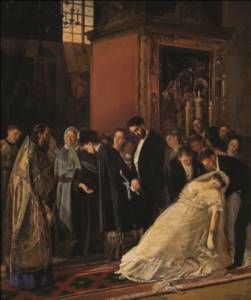
Vasily Pukirev. An interrupted wedding. 1877. Azerbaijan State Museum of Art, Baku
“The Interrupted Betrothal” by Adrian Volkov
In the paintings of the Itinerants and other Russian realists of the second half of the 19th century, one can often find scenes from merchant life, which at the same time began to be actively ridiculed on the theater stage, especially by Ostrovsky. This one depicts the groom of a merchant's daughter, whose engagement is disrupted due to the appearance of his former lover with a baby in her arms. Scandal! From the sketch it is clear that the plan was bolder: there is a daughter in a snow-white dress, that is, it was not the engagement that was disrupted, but the wedding itself.
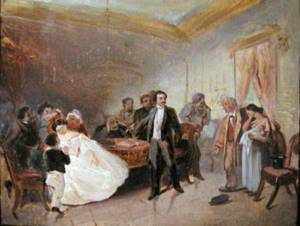
Adrian Volkov. Interrupted engagement (sketch). Chuvash State Art Museum, Cheboksary
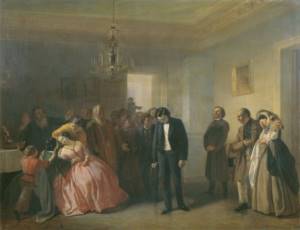
Adrian Volkov. Broken engagement. 1860. State Tretyakov Gallery, Moscow
Surviving modern customs
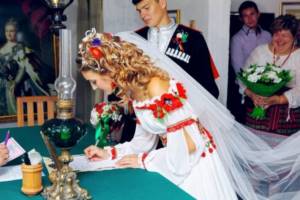
Some wedding traditions and customs of the Russian people, which were observed by our ancestors, have survived in their true or slightly modified state to this day. In most cases, they no longer carry a sacred meaning, but are only a tribute to past times.
- Engagement (according to the old order, collusion). This word means an announcement to all friends, relatives and acquaintances that the wedding will take place. Both before and now, after the engagement, the main preparations for the wedding began - a specific date was determined, the necessary products were prepared. This was one of the important wedding ceremonies of the Russian people.
- Bachelorette and bachelor parties (youth party). Girls gathered with their girlfriends, and boys with friends. However, previously these events were of a different nature; it was assumed that the bride and groom during them should cleanse their soul and body before the wedding. This was done in a bathhouse, and at this time many tears were shed on the part of the bride, and endless howls were heard, since this was required by the Russian wedding ceremony.
- Bride ransom. The groom had to prove that he was worthy of the chosen girl. To do this, he underwent all sorts of tests prepared by his relatives and bridesmaids. Now this custom has practically not changed - the only differences are in the tests for the young man. He still has to show his dexterity and ingenuity, and in some cases also pay a ransom.
- Stealing the bride's shoe. At some weddings, in the midst of the feast, you can find a prank - the shoes of the hero of the occasion are stolen, and the newly-made head of the family has to look for the loss. Previously, this Russian folk wedding ceremony was a little different - the bride herself would give her shoe to her friends to try on, and the one whose shoe fit would demand a ransom from the groom.
- Dance of the young. This is one of the few traditions that has survived unchanged to this day. The dance usually took place at the end of the celebration, and all the friends and relatives watched the newlyweds. Many Russian folk wedding traditions and customs are honored to this day. And the dance of the young is no exception.
Nobody forces modern couples to follow the long-standing wedding traditions of the Russian people, because in fact, these are relics of the past. They need to be remembered and honored, but not necessarily observed. If the bride and groom nevertheless decide to use such a spectacular move for their celebration, then they should make sure that everyone understands them correctly.
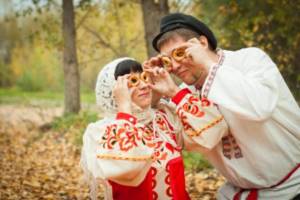
Russian culture has always been famous for its rich history with many traditions and customs. Modern newlyweds often have a desire to return to their roots, and this is commendable, since one should not forget one’s own roots. Those present at the wedding will probably experience a slight thrill from contemplating long-standing traditions that are close to the Russian soul.
“To the crown (Farewell)” and “Choice of a dowry” by Vladimir Makovsky
The famous genre artist Vladimir Makovsky was not afraid of comparison with Pukirev: he painted his wedding paintings 40 years later. But a modern viewer will not notice much difference in the style of their painting. And the clue is right before your eyes - the style of the wedding dress. Although the basic set of attributes remains unchanged - a veil, an orange blossom wreath, white fabric, the fashionable silhouette has changed noticeably. In Pukirev’s painting, painted in 1862, the bride is wearing a large, bulky crinoline; You can’t run away from under the aisle with something like that. But for brides of the 1890s, the skirt was significantly narrowed and looked much more comfortable. It is curious that brides of the 21st century still prefer the style of a century and a half ago, with crinolines.
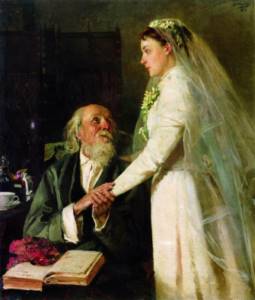
Vladimir Makovsky. To the crown (Farewell). 1894. Samara Regional Art Museum, Samara
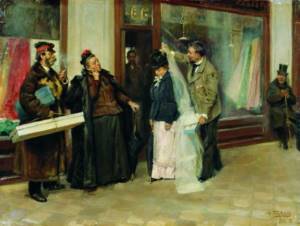
Vladimir Makovsky. Choice of dowry. 1897-1898. Kharkov Art Museum, Kharkov
“Before the Wedding” and “After the Wedding” by Firs Zhuravlev
Zhuravlev’s painting “Before the Crown,” for which he received the title of academician, was so popular that he painted a second version of it. The first, from the Russian Museum, is full of witnesses, and the costumes and attributes clearly emphasize: the family is a merchant, that is, you can laugh at them. The second option, from the Tretyakov Gallery, is more laconic and tragic: the matter here is only between father and daughter. The painting was called both “The Blessing of the Bride” and “Marriage by Order”... In the later painting, “After the Wedding”, the interior is elegant, aristocratic, and the father is a nobleman (he has no beard, and on his neck is not a round medal, but a cross ). But the bride is still crying.
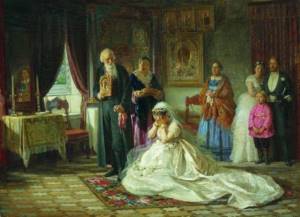
Firs Zhuravlev. Before the crown. 1874. State Russian Museum, St. Petersburg
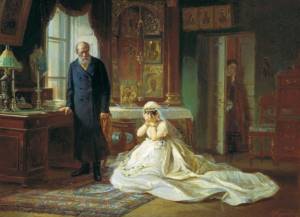
Firs Zhuravlev. Before the crown. Until 1874. State Tretyakov Gallery, Moscow
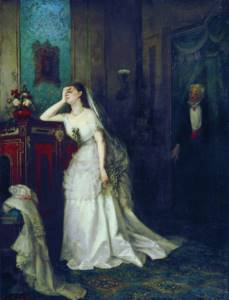
Firs Zhuravlev. After the wedding. 1874. Tambov Regional Gallery, Tambov
Details
Witnesses
In Russia, it is customary at weddings to have witnesses who will be with the newlyweds throughout the entire celebration. They also accompany their lovers to the registry office. The official ceremony takes place in a beautifully decorated wedding hall accompanied by solemn music. Rarely, when young people do not want much excitement, then you can schedule the painting for a weekday and hold the event in a calm atmosphere. Usually, the ceremony is held in the presence of numerous guests. The registry office employees take organization very seriously.
The registrar says beautiful and exciting words to the newlyweds, asks the most important question about the reciprocity of the decision being made. Next, the newlyweds exchange rings and only after that the registry office employee invites the newlyweds to seal their decision with signatures in the civil status act. The culmination is the wedding waltz. Guests congratulate the newlyweds, then move to another room where a photo shoot takes place, where they can relax and drink champagne. On their way out, the newlyweds are greeted with joyful cries of “Congratulations!” and are showered with coins, rice and rose petals. A newly born young family releases doves into the sky, which are considered a symbol of love and fidelity.
Wedding
There are a lot of young couples who want to seal their union not only in the registry office, but also by getting married in a church. As a rule, the closest people are invited to this sacrament. The ritual itself lasts about an hour.
In most cases, if there is no wedding ceremony, the newlyweds, after the ceremonial part in the registry office, will have a walk around the city, in a new capacity: husband and wife. They visit various memorable places, beautiful squares and parks. The entire walk is accompanied by a cameraman and photographer, who choose the most beautiful options for video and photography.
Banquet
At the end, the newlyweds and guests will enjoy a gala banquet. The presenter you choose means a lot. An experienced toastmaster will think through everything and take into account all your wishes. His task is to make the evening unforgettable; he must organize not only entertaining competitions, but also decorate the hall and properly seat the guests. The toastmaster can recommend a DJ and florists, because he has enormous experience, which increases with every event held.
At the entrance to the banquet hall, the newlyweds are met by the groom's parents with a symbolic loaf and an icon, which should bless the young family for a long married life. This is a very beautiful rite, and then there will be no less important ones: entry into family life, the process of transferring fire from the family hearth of the bride’s parents to the newly formed young couple. All these events are accompanied by solemn promises and oaths - these are very touching moments that are very emotionally perceived by the participants and others.
Bouquet
At the end of the evening, the bride throws her wedding bouquet to the unmarried girls, thereby passing the baton. There is a belief that the girl who catches the bouquet will soon get married. The groom must remove the garter from his young wife's leg with his teeth and throw it to his friends, thereby determining the next guy who will say goodbye to his single life.
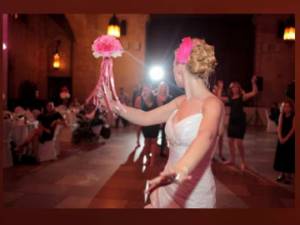
Throughout the entire feast, those invited make toasts, congratulating and praising the newlyweds. Auctions are held and gifts are given. The highlight of the evening, as a rule, is a cake of extraordinary beauty. After the dessert is distributed to the guests, the newlyweds should thank everyone present for sharing the joyful event with them, spending this unforgettable day with them.
At the end of the event, as a rule, there is a fireworks display in honor of the newlyweds, and lanterns or balloons are launched into the night sky.
Russian weddings are celebrated with grandeur and fun. Often, the first wedding day is followed by the second wedding day. It consists of a usual cheerful feast. After the wedding, the newlyweds usually spend their honeymoon enjoying each other.
“Waiting for the Best Man” by Illarion Pryanishnikov
However, Russian artists cannot be praised for the originality of the tragic theme: exactly in those same years, throughout Europe, canvases about unhappy brides were being painted. In the Victorian era, when capital began to dominate and many rich old people divorced, the topic of unequal marriages became very relevant. Besides, crying girls in white just look spectacular! The names of the paintings speak for themselves: “Till death do us part” (Edmund Blair Leighton), “The Unhappy Bride” (Auguste Tolmush), “The First Tear” (Norbert Goenette), “The Rejected Bride” (Edward Svoboda) and so on...
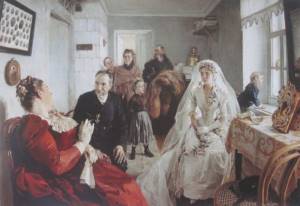
Illarion Pryanishnikov. Waiting for the best man. 1880s. Serpukhov Historical and Art Museum, Moscow region, Serpukhov
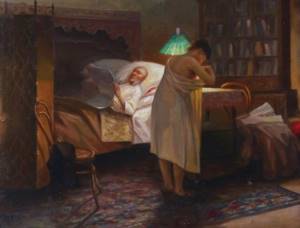
Illarion Pryanishnikov. At a quiet pier. 1893. State Russian Museum, St. Petersburg
“Wedding in Prison” by Nikolai Matveev
However, Russian art differed from European art in one way: the painters were progressive and had a liberal attitude towards numerous prisoners. After all, these were political prisoners - revolutionaries and terrorists who fought the regime, heroes and devotees, as the intelligentsia of that time believed. Hence such benevolent prison films as “They Didn’t Expect” and “Refusal of Confession” by Repin, “Life Everywhere” by Yaroshenko, “By Stage” by Vladimir Makovsky, etc. Therefore, it is not surprising that a picture about a prisoner’s wedding appeared. The bride, alas, is not in white, but now it will be much easier for her to obtain permission to visit.
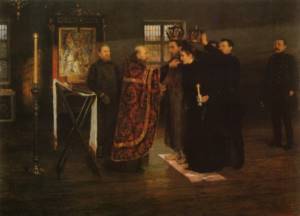
Nikolay Matveev. Wedding in prison. 1890. National Museum of Fine Arts, Chisinau
Modern Russian wedding
The Bride and Groom in Russia meet and decide about the wedding themselves. Sometimes it happens that parents find out about their “children’s” wedding after registration. Most often, however, all possible relatives, as well as friends on VKontakte, etc. know about the wedding in advance. Russians plan the date of marriage registration (this strange word refers to the beginning of life together in Russia) from six months to a month in advance.
During these six months, the bride (grooms often don’t bother much with preparing for the wedding) lives in constant stress. Preparations for a wedding happen both in dreams and in reality. You need to have time to make a list of guests, find a cafe or catering facility for the banquet, figure out where to go for a walk with the photographer after registration, where to get normal shoes, what frills will be on the dress, etc. In this, Russian traditions are not very different from any others. In general, for some brides the pre-wedding six months are a real madhouse.

The bride's wedding dress is traditionally white. Before the time of Catherine, the second bride's outfit in Russia was red. The white dress of the bride, which now symbolizes purity and purity, came from Ancient Greece - there it was a symbol of joy and prosperity. Catherine got married in a white dress and thereby categorically changed Russian tradition.
The wedding day, like in any other country, begins with hair, makeup and dressing. This happens differently for everyone: the bride can do her hair and makeup in a beauty salon with a specially trained hairdresser and makeup artist, or maybe in her own room with improvised tools.
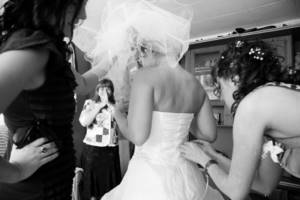
The groom needs less time and effort to prepare.

But sometimes other challenges fall on him (decorating a car, getting a wedding bouquet, and so on).
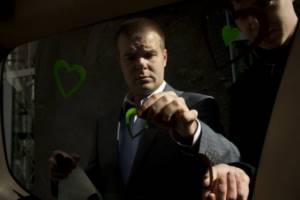
Meanwhile, the bride continues to be in a commotion. After all, this isn’t just about buying some bouquet (pre-selected by the bride), but you need to arrange your curls correctly, lace up your dress and all that stuff - these are more serious matters.
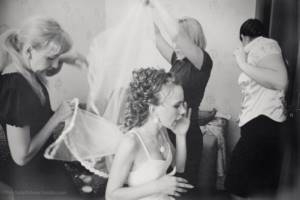
Parents and girlfriends also participate in the preparation: they rush around the apartment, checking whether all the bottles have been transferred to the cars, whether there are enough sandwiches for the walk, whether everything is ready to meet the groom and whether he has already arrived.
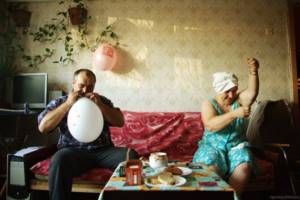
And so, a car pulls up, the groom gets out with a bouquet, and then...the ransom begins. The procedure takes place in the entrance of the bride's house.
Redemption is perhaps the oldest tradition preserved in Russian weddings. Its meaning is fan. The bridesmaids need to torture the groom as cheerfully as possible, ask him a bunch of stupid tasks and riddles and at the same time receive a ransom from him - this could be money or some goodies that he doesn’t mind giving for the bride.

Meanwhile, the bride is finishing her preparations.
If she doesn’t have time, then the groom gets more.
In the end, the groom is allowed into the house, where he still needs to find a bride. Because even here they are trying to deceive him.
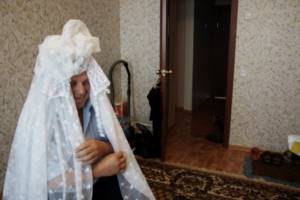
In the end, he finds a bride, and everyone drinks champagne on this occasion. Then a moment occurs, the roots of which have been preserved in modern times from antiquity, when the mother handed over the so-called “talisman” to the bride. It could be jewelry or some kind of family heirloom. These talismans were highly valued and were not sold under any circumstances. The bride, in turn, passed them on to her daughter on her wedding day. This sometimes happens at modern weddings too.
“The Wedding of Nicholas II and Alexandra Feodorovna” by Laurits Tuxen and Ilya Repin
The bride in these paintings is the Hessian Princess Alice, in Orthodoxy - Alexandra Feodorovna, and, of course, she is not at all sad. On the contrary, he is triumphant. After five years of waiting, her dreams of marriage with her beloved, and in addition the emperor, came true, no matter how the groom’s relatives objected. But we know that this wedding is the saddest of all. Because it is real, and not invented by the painter. And it will lead to tragedy not only for this family, but for the whole country.
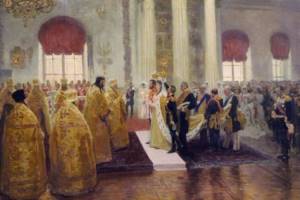
Ilya Repin. The wedding of Nicholas II and Alexandra Fedorovna. 1894. State Russian Museum, St. Petersburg
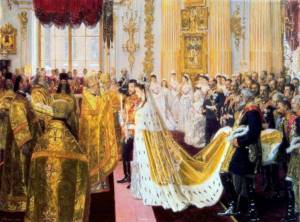
Laurits Tuxen. The wedding of Nicholas II and Alexandra Fedorovna. 1895. State Hermitage Museum, St. Petersburg
Russian wedding dress
Russian wedding folk costumes are of particular cultural value. They are part of the history of our country, however, even in modern times, Russian wedding dresses arouse keen interest. Russian style and its unique wedding traditions remain a source of inspiration for many designers, and, of course, modern brides and grooms.
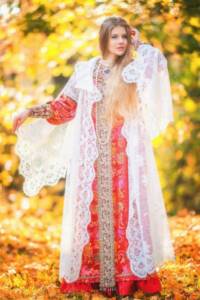
Features of Russian wedding costume
Russian wedding suits differed from everyday clothes, first of all, in their color scheme, materials of manufacture, and decor. Every detail of the outfit (and there were many of them - a wedding suit in Russia was multi-item ) had its own meaning. Key differences also include the way they are worn. As for the cut, it was approximately the same as for everyday clothes - loose, straight, not focusing on the features of the physique.

Russian dress with Mstera embroidery
Natural home-made fabrics - linen, wool - were chosen as materials for making wedding dresses. Wedding shirts were made from flax, thin and light, and brides' sundresses were made from denser fabrics.
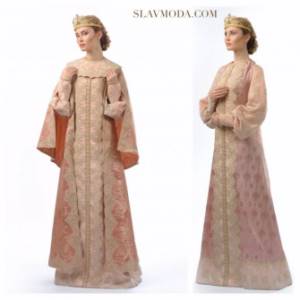
Dress in Russian style
The choice of material depended on the wealth of the bride's family. Girls from wealthy families could afford clothes made from expensive purchased materials - velvet, brocade, silk. The clothes of brides from peasant families were made from simple fabrics, but they looked no less luxurious - due to the exquisite decor , which was the embodiment of the unique talent of Russian needlewomen. As you know, it was peasant girls who perfectly mastered the art of decoration. And they most clearly showed their amazing talent in decorating wedding dresses.
Unique sundress decor
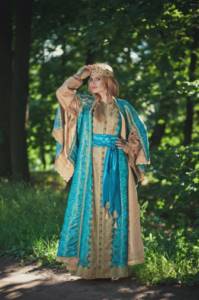
Russian style wedding
The basis of a bride's wedding dress in Russia was a sundress . These clothes were decorated with gold and silver threads, beads, and bright braid. The most beautiful, of course, were the sundresses of brides from rich, noble families. They were made from luxurious fabrics, including brocade, and decorated with natural pearls and valuable fur. Spectacular and expensive decor made the clothes not only beautiful, but also quite heavy: the sundresses of rich brides could weigh about 10 kg or even more.











